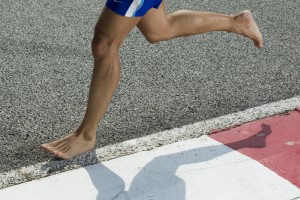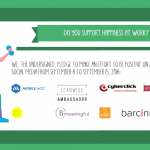The following post was written by Oriol Roda, founder and CEO of Mammoth Hunters, the Barcelona-based startup that is a virtual lifestyle advisor based on the Paleo philosophy. Utilizing a combination of training and nutrition, Mammoth Hunters removes all barriers to help people live a healthier life with the latest trends on health and physical performance. Oriol holds a PhD in molecular biology and an MBA from ESADE business school in Barcelona.
We are living through a massive epidemic that is pervasive in almost all modern societies, a major issue in our personal lives and one of the biggest threats we face as a society. It’s the deterioration of our personal health and it’s getting worse year after year.
The two main causes of this epidemic:
Bad food habits and a sedentary life style.
Indeed these two factors are linked in a very destructive way, as we will describe in this article. But let’s start by analyzing them separately:
Bad Food Habits
As modern societies move away from nature, the food we eat has become less and less nutritious (although more caloric). Reasons for that are intensive farming (that primes production over quality) and the type of food that we eat. In addition, we live in a frenetic society where time is scarce and we end up eating fast processed food. The result is that the incidence of certain diseases has skyrocketed and that we are getting more and more fat and sad every day.
Overweight problems are one of the main causes of diabetes, heart attacks, cancer, Alzheimer’s and many other diseases. It also lowers our immune systems, making us more prone to infections and diseases. As if obesity was not enough of a problem, we have to add another critical issue related to food: we don’t eat the right kind of nutrients.
 In places like the US, this problem is so extreme that 2/3 of the population is overweight. In Europe, we don’t do that well either with around 50% of the population in this group as well.
In places like the US, this problem is so extreme that 2/3 of the population is overweight. In Europe, we don’t do that well either with around 50% of the population in this group as well.
Let’s make it clear that we don’t consider “fat” a problem. Our ability to accumulate fat has allowed humans to survive in the “normal” natural world, where food was scarce and there were periods of draughts, famine, etc… However, we don’t live in a world of food scarcity anymore (at least in developed countries), and we also don’t eat the same foods that our ancestors did. Our metabolism is so fine tuned to survive in the wild, that it does not do well when overloaded with sugar and other unnecessary foods it cannot process.
Surely you have seen how more and more people develop intolerance to lactose or to gluten and how food allergies are rampant. You can imagine the huge personal and social cost that this is causing.
Sedentary People
The other part of this disastrous equation is that people don’t move enough. Again, our stressful lifestyle that leaves no time for leisure paired with the fact that we changed active jobs to “in-front-of-the-computer” ones has created a generation of fluffy people that get tired from climbing a couple of stories via stairs.
Did you know that hunter-gatherers were super lean? 50% of their body mass was pure muscle! Now we are happy if we reach 30%.
This is more important than you might think at first. To begin with, a lack of exercise means that we burn less calories and thus increases the problem of bad food habits. Additionally, it causes problems of its own. Muscle is a huge homeostasis regulator; it controls levels of insulin in blood and maintains a stable blood pH.
It has long been known that exercise is one of the most powerful interventions you can do to improve health. The more exercise you do, the better (within reasonable limits). It improves your immune system, it brings more energy, it makes you more resilient to stress and exhaustion, etc… In fact, it is well known that exercise even makes you happier!
Paleo is a Solution
So how is that we ended up in such a situation?
This is the question that the Paleo movement is trying to answer. The main premise of this movement is that modern humans have spent 95% of their history in the Paleolithic period and that our body and mind are adapted to this environment.  Modern life is a very recent event in evolutionary terms, and there has been not enough time for us to fully adapt to it.
Modern life is a very recent event in evolutionary terms, and there has been not enough time for us to fully adapt to it.
The origin of this movement can be traced to an article published in 1985 in the prestigious New England Journal of Medicine. This publishing made the movement scientifically relevant. In recent years, authors such as Loren Cordain, Robb Wolf, Mark Sisson and others have popularized the concept. Now it has become a mainstream movement, even being the number 1 Google trend for nutrition in 2013. Another branch of the Paleo movement is the barefoot running style. This started as a freakish way to run, but all major brands have their own line of minimal shoes.
In Spain, the Paleo movement came late but is now catching up, especially among athletes that follow the Paleo Training and people with food intolerances such as celiac or lactose intolerance. This weekend Barcelona will become the European capital of Paleo with the first summit ever made in the continent: http://summitpaleo.com/.
Let’s analyze a little bit what the Paleo movement says about nutrition and sport:
Nutrition
As opposed to what many people think, Paleo Diet is not about eating a lot of meat. Paleo Diet is defined by discouraging the intake of certain nutrients. The main idea is that a lot of the food we eat nowadays can be considered anti-nutrients. This means that they cause more harm than good to our bodies. Let’s look at 3 examples:
Cereals: Our main sources of energy nowadays are wheat and corn. These are very modern cereals and although they bring us plenty of calories, they come at a cost. They have inflammatory effects in our guts and mess up our metabolisms. One example of this intolerance is celiac disease, which is an acute expression of a problem almost all of us have at some degree.
Sugar: Worse than cereals is refined sugar. In fact, many doctors consider sugar to be a drug as bad as alcohol or tobacco. It causes addiction, it affects our mood and can be a trigger to diabetes.
Milk: Another nutrient we are not used to is milk. In fact, humans are the only species that drink milk during adulthood, which should make us suspicious about its benefits. Milk was a great source of energy for Europeans during a time when food was scarce, but it came at a cost as it has pro-inflammatory effects. Nowadays, we don’t need it anymore.
But if we don’t eat cereals, where do we get our energy from?
Easy: FATS
Fat has been demonized for many years and it’s not been until recently we have rediscovered it as an important and healthy source of energy. Now it is clinically accepted that eating fat does not make you fat, nor does it promote arterial clogging or high cholesterol. In fact, it’s the other way around. Fat is the main source of energy for humans, which is why we store fat and not carbs in our bodies. By eating fat regularly, we train our bodies to burn it more efficiently. Nutrients like coconut, avocado and olive oil are super reach in fat and considered extremely healthy. Even bacon is having a revival, being one of the major trends in the US.
Another important element to consider in our diet is how often we eat. In ancient days, food was scarce and 3 meals a day was a luxury few could afford. In fact, our body is not prepared to eat so often and it has been shown that short periods of fasting can be super beneficial. Some studies even link it to longevity! In the Paleo world we say our body has two states: nourishing and regeneration. We eat to get energy, but it’s only when we fast that we regenerate. The concept is similar to training: you exercise to trigger a change in your body, but it’s when you sleep that your body rebuilds muscle and gets stronger. This is why we recommend two major intakes of food per day with 16 hours of not-eating.
Sport
The Paleo Training (or how to approach to sport form a Paleo perspective) is also quite interesting. The main idea is to exercise in a manner that simulates the natural environment.
First of all, we consider that moving is a means to do something. We move to get food or to escape from danger or to accomplish something specific. This is the kind of movement our mind understands and favors. This means that any kind of sport that is “meaningless” has no benefits and will not trigger the same amount of change. Take as an example running on a treadmill. Can you imagine something more miserable than running to go nowhere? Do you think this is something our brains will promote? Another example is exercising after eating. What do lions do after a feast? They sleep! Why would they go running around? They need to put their energy into digesting the food, plus the more they run for no purpose, the more chances they have to starve later (remember food is scarce in the real world!). This is why in Paleo we talk about functional exercises and exercising with an empty stomach.
In addition, movements have to be unexpected and surprising, never repetitive (real life is not predictable) and it has to be a combination of high intensity with periods of endurance, as this how humans used to hunt.
Finally, in Paleo Training we give a lot of importance to emotions. Exercise has to be rewarded. Again the main idea behind this is that we move to accomplish something, so by emotionally engaging with the movement, we signal our brains to encourage improvement.
How can we Change?
Paleo Diet and Paleo Training provide a natural solution to one of the major problems in our society, but they are complex to implement. They require a change in food and sport habits, which is not easy. This is where the Internet and technology helps a lot.
There are amazing resources online to help you learn how to eat and how to move in a Paleo style. You can check the world’s famous Mark’s Daily Apple or the web of Loren Cordain for ideas on nutrition. There are many other blogs, Facebook groups and even a Meet up in Barcelona.
There are also many apps that help you track sport and food. Endomondo, MyFitnessPal, Moves etc. are really good tools to record your daily steps of what you eat. And there is also, of course, Mammoth Hunters, a start up here in Barcelona that has developed an app to create personalized training and nutrition plans that are 100% Paleo.








This a great article!. I’m happy I’ve learnt about a way to live healther that looks so easy to put into practice!!. To me it seems feasible (for sure) to slightly change food habits and, what’s even better, there are apps out there (e.i. Mammoth Hunter) that can create Paleo physical exercise so one doesn’t have to get into this Paleo movement without guidence. This is so convenient !! :-))